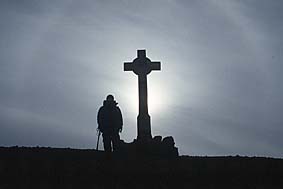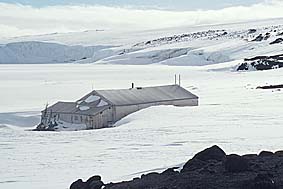 Antarctic
History
Antarctic
History
Reference to historical events associated with Antarctica offers a
novel, interesting and exciting platform for specific issues ranging
from the extreme nature of the physical environment (climate or
geology, for example) to the need for environmental protection
(pollution or whaling, for example). A substantial summary of early
Antarctic history is provided by Harrowfield (1990).
Early History
- Ancient Greeks named southern continent
Anti-Arkitos.
- Referred to later as Terra Australis Incognita (the
unknown southern land)
The Exploratory Age
(1772-1894)
- James Cook (1772-1775) in the Resolution and the
Adventure sailed to 71°
10’S and aroused the interests of sealers and whalers on his
return.
- Thadeus von Bellinghausen (1819-21) in the Vostok and
the Mirnyi reached 69°
53’ and sighted the Antarctic continent for the first
time.
- Dumont d’Urville (1837-1840) in the Astrolabe and
the Zelee reached 66°
S.
- Charles Wilkes (1838-1842) led a small flotilla of the
Vincennes and 5 other ships.
- James Clark Ross (1840-1843) led the first British Antarctic
Expedition in the ships Erebus and Terror. They
reached 78° 17’S and
discovered the Transantarctic Mountains, the Ross Sea, the Ross
Ice Shelf, Victoria Land, Ross Island, and Mts. Erebus and
Terror.
The Heroic Age (1895-1915)
- Henryk Bull (1895) managed a whaling expedition south in the
Antarctica and landed on the continent. Carsten
Borchgrevink claimed to be the first, although this was disputed
by a 17 year old, Alexander von Tunzelman, who claimed he leapt
out to hold the boat steady.
- Adrien de Gerlache (1897-1889) sailed south in the
Belgica and over-wintered in 1898 when they became trapped
in the pack ice in the Bellinghausen Sea. This expedition is also
noteworthy because among the crew was the young Amundsen making
his first trip south.
- Carsten Borchgrevink (1898-1900) returned to Antarctica in the
Southern Cross. They over-wintered through 1899 at Cape
Adare. The zoologist Nicolai Hansen died on 14 October 1899
becoming the first person to be buried on the Antarctic continent.
During their stay they sledged to 78°
50’S, setting a new southerly record.
- Robert Falcon Scott (1901-1904) made his first of two trips
south in the Discovery. The ships was frozen in at Winter
Quarters Bay (Ross Island) in 1902 and they built a hut nearby
(adjacent to the current McMurdo Station). Able Seaman George
Vince lost his life on 11 March 1902 when returning across the
island with others from Cape Crozier. Scott, Edward Wilson and
Ernest Shackleton reached 82°
17’S on 30 Dec 1903. A party led by Armitage reached the
polar plateau for the first time and on their return discovered
the Taylor Valley, one of the Dry Valleys. The relief ship the
Morning arrived in January 1903 under Captain Colbeck and
left with Shackleton (who suffered from scurvy on the push south)
and a number of others. The rest stayed behind to overwinter
another season. In January 1904 the Morning returned with
the Terra Nova under Captain Mackay, the Discovery
was freed using explosives, and the ships left for New
Zealand.

The cross erected on Hut Point
(Ross Island) in memory of George Vince.
- Ernest Shackleton (1908-1909) returned in the Nimrod
which was towed to the pack ice by the Koonya to save coal.
His group built a hut at Cape Royds on Ross island. A party
of six led by T. W. Edgeworth David climbed Mt. Erebus in March
1908. One (Brocklehurst) had severely frost-bitten feet and had to
be left behind at an overnight staging point. The round trip from
Cape Royds took 6 days. Shackleton, Jameson Adams, Eric Marshall
and Frank Wild got to 88°
23’S (148 km from the pole) on 9 January 1909, discovering
the route up the Beardmore Glacier to the Polar Plateau later used
by Scott. Edgeworth David, Douglas Mawson and Forbes Mackay
reached the South Magnetic Pole on 16 January 1909.
- Roald Amundsen (1910-1911) sailed south in the Fram. He
ascended the Axel Heiberg glacier with Hanssen, Wisting, Hassel
and Bjaaland and reached the South Pole (90° S) on 14 December 1911.

A Scott Base
husky.
- Robert Scott (1910-1913) returned in the Terra Nova and
built their expedition hut at Cape Evans. Edward Wilson, Henry
Bowers and Apsley Cherry-Garrard undertook "the worst journey in
the world" to Cape Crozier in the middle of winter. Scott, Wilson,
Bowers, Lawrence Oates and Edgar Evans reached the South Pole on
17 January 1912 (about a month after Amundsen) only to perish on
the return journey. Victor Campbell and other members of the
northern party were forced to overwinter in an ice cave on
Inexpressible Island in Terra Nova Bay. The Terra Nova
returned on 18 January 1913.

Scott's hut at Cape
Evans.
- Douglas Mawson (1911-1914) led the Australian Antarctic
Expedition sailing south in the Aurora. This expedition is
memorable for Mawson’s epic sledging journey in which his
companions Belgrade Ninnis and Xavier Mertz lost their lives.
- Ernest Shackleton (1915-1917), having been beaten to the pole,
planned a third expedition (the Imperial Trans-Antarctic
Expedition) using two ships. The Aurora carried a group to
lay depots to the bottom of the Beardmore Glacier, while the
Endurance was to deposit the crossing party on the other
side of the continent. However, the Endurance became
trapped in the ice and sank in November 1915 and the crew of 28
took to the boats reaching the comparative safety of Elephant
Island. From here, Shackleton and five others sailed the James
Caird 1300 km to South Georgia and ultimately organised the
rescue of the rest of the crew. Meanwhile, the Aurora was
taken out to sea in a blizzard and obliged to return to New
Zealand leaving a party of 10 under A. L. A. Mackintosh stranded
on Ross Island. This group laid the planned depots the following
austral summer, but on the return journey the Reverend A. P.
Spencer-Smith died. Two others (Mackintosh and Hayward) also
perished when they attempted to cross the sea ice from Hut Point
to Cape Evans. The survivors were ultimately rescued by the return
of the Aurora with Shackleton on board.
The Mechanical Age
(1916-1954)
- The Ross Dependency was established and administered by the
Governor General of New Zealand on 30 July 1923.
- Richard Evelyn Byrd (1929-1930 and 1933-1935). Sailed to
Antarctica in the City of New York and established Little
America in the Bay of Whales.
- In October 1956 an R-4D Dakota (Que Sera
Sera) landed at the South Pole and the construction of a
permanent base began.
- The International Geophysical Year (1957-58) increased
scientific activities in Antarctica with over 5000 personnel being
involved. The year paved the way for the Antarctic Treaty.
- New Zealand established their Scott Base at
Pram Point (3 km from McMurdo Station) in January 1957.
- Sir Vivian Fuchs, with Sir Edmund Hillary, led the
Commonwealth Trans-Antarctic Expedition. Hillary’s team
became the first since Scott to reach the South Pole, while
Fuchs’ team was the first to complete a trans-Antarctic
crossing.
- The Scientific Committee on Antarctic Research (SCAR) was
established in 1958.
Question
- Write in support of establishing Antarctica as a World
Heritage Park emphasising its unique features.
